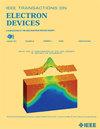A Groove-Loaded Folded Waveguide Slow Wave Structure With Vertical Beam Tunnel for Power Enhancement in Sheet Beam Sub-THz TWTs
IF 3.2
2区 工程技术
Q2 ENGINEERING, ELECTRICAL & ELECTRONIC
引用次数: 0
Abstract
To enhance the output power and beam–wave interaction efficiency of sheet beam (SB) traveling wave tubes (SB-TWTs) operating in the subterahertz frequency range, this study proposes a novel groove-loaded folded waveguide (GLFW) slow wave structure (SWS) with a vertical beam tunnel. GLFW-SWS overcomes size limitations associated with operating frequency, thereby allowing for a broader lateral dimension of the beam tunnel. It effectively expands the width of the beam tunnel while minimizing reflection. Compared with the traditional folded waveguide (FW) SWS, the average interaction impedance in the interaction region is increased by 50%. In the subterahertz frequency range (218–220.5 GHz), the utilization of GLFW-SWS leads to a great improvement in the output power level of the TWT. Combined with a phase velocity tapering optimization method, at cathode voltages and current of 25 kV and 0.4 A (focused current density of 341 A/cm2), respectively, output power exceeding 1.01 kW can be achieved at 219.6 GHz. The interaction efficiency is over 10.1%. The transmission and dispersion characteristics are experimentally verified. This development offers a promising solution for subterahertz sources in next-generation communication.带垂直波束隧道的槽载折叠波导慢波结构用于片状亚太赫兹行波管的功率增强
为了提高工作在亚太赫兹频率范围内的片状束行波管(SB- twts)的输出功率和波束相互作用效率,本研究提出了一种具有垂直波束隧道的新型槽载折叠波导(GLFW)慢波结构(SWS)。GLFW-SWS克服了与工作频率相关的尺寸限制,从而允许更宽的波束隧道横向尺寸。它有效地扩大了光束隧道的宽度,同时最大限度地减少了反射。与传统的折叠波导(FW) SWS相比,其相互作用区域的平均相互作用阻抗提高了50%。在次太赫兹频率范围内(218-220.5 GHz),利用GLFW-SWS可以大大提高行波管的输出功率水平。结合相速度渐变优化方法,在阴极电压为25 kV、电流为0.4 a(聚焦电流密度为341 a /cm2)时,219.6 GHz的输出功率可超过1.01 kW。相互作用效率大于10.1%。实验验证了其传输和色散特性。这一发展为下一代通信中的次太赫兹源提供了一个有前途的解决方案。
本文章由计算机程序翻译,如有差异,请以英文原文为准。
求助全文
约1分钟内获得全文
求助全文
来源期刊

IEEE Transactions on Electron Devices
工程技术-工程:电子与电气
CiteScore
5.80
自引率
16.10%
发文量
937
审稿时长
3.8 months
期刊介绍:
IEEE Transactions on Electron Devices publishes original and significant contributions relating to the theory, modeling, design, performance and reliability of electron and ion integrated circuit devices and interconnects, involving insulators, metals, organic materials, micro-plasmas, semiconductors, quantum-effect structures, vacuum devices, and emerging materials with applications in bioelectronics, biomedical electronics, computation, communications, displays, microelectromechanics, imaging, micro-actuators, nanoelectronics, optoelectronics, photovoltaics, power ICs and micro-sensors. Tutorial and review papers on these subjects are also published and occasional special issues appear to present a collection of papers which treat particular areas in more depth and breadth.
 求助内容:
求助内容: 应助结果提醒方式:
应助结果提醒方式:


